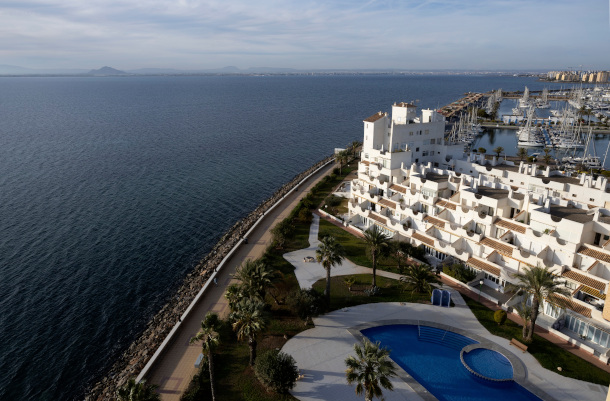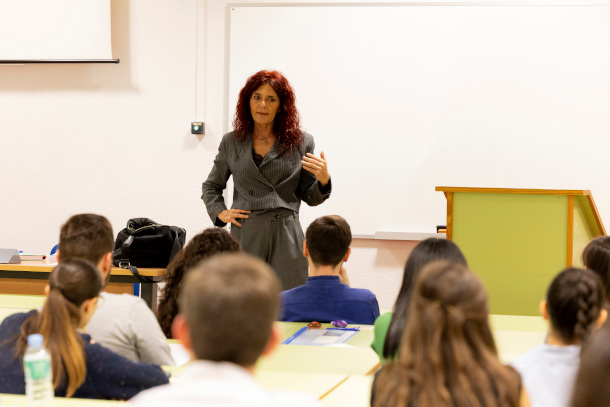The "Little Sea" with a Big Champion
Air Date: Week of May 24, 2024

Teresa Vicente is a professor of philosophy of law at the University of Murcia. (Photo: Goldman Environmental Prize)
The Mar Menor or “little sea” lagoon on the coast of Spain faces impacts from mining, agriculture, and a booming tourist industry. Teresa Vicente is a professor of philosophy of law at the University of Murcia who helped pass a 2022 law granting the lagoon legal personhood to give it greater protection. She recently received the 2024 Goldman Environmental Prize for Europe and joins Host Aynsley O’Neill to share how she led a grassroots movement to protect this beloved lagoon.
Transcript
BELTRAN: It’s Living on Earth. I’m Paloma Beltran.
O’NEILL: And I’m Aynsley O’Neill.
The Mar Menor or “little sea” lagoon on the coast of Murcia, Spain, used to be a pristine saltwater home to a vital marine ecosystem. But mining, agriculture and a booming tourist industry have threatened this fragile coastal area. Teresa Vicente is a professor of philosophy of law at the University of Murcia, and she spearheaded a grassroots movement to protect the beloved Mar Menor. Her work led to the passage of a law in 2022 granting the lagoon legal personhood, the first recognition of legal rights for a European natural feature. For her activism, Teresa was granted the 2024 Goldman Environmental Prize for Europe, and she joins me now. Teresa, welcome to Living on Earth!
VICENTE: Thank you very much. I'm very happy to be here with you.
O'NEILL: So tell me about the Mar Menor, or “little sea” lagoon in Murcia, Spain. What is so special about this ecosystem?

Ms. Vicente spearheaded a movement to provide legal personhood to Mar Menor, the largest permanent saltwater lagoon in Europe. (Photo: Goldman Environmental Prize)
VICENTE (TRANSLATED): Mar Menor is a saltwater lagoon that's 130 square kilometers with a sand dune that separates the lagoon from the Mediterranean. These sand dunes used to be marvelous, but now they're occupied by unsustainable urbanization. And the basin of the lagoon, which also has rights because it's in the same ecosystem, is 1,660 square kilometers. Since the 1960s, it's been severely impacted by the mining industry because the runoff from mining would spill and make its way into the lagoon. During the 70s, there was a lot of development and urbanization in the watershed and basin. And in the 80s, the agricultural industry and intense cattle farming really provoked the lagoon's collapse. And in recent decades, agriculture and livestock have definitely been the biggest threats to the lagoon.
O'NEILL: And Teresa, with all of these issues, what inspired you to work to protect Mar Menor?
VICENTE (TRANSLATED): For all Murcians, as well as for the Spanish community, but especially for Murcians, the Mar Menor is a vital part of our cultural identity. We're emotionally attached to it, and it forms an integral part of our lives. And in 2016, when Mar Menor's wildlife was dying right in front of our eyes, that's when the community started to wake up to what was happening. I'm from the generation that’s seeing the effects of climate change firsthand. So I started to ask myself, why does social responsibility law not account for how humans are responsible for the destruction of nature? And I had already been studying for a while the possibility of granting rights to nature. So I presented my idea to the community and they agreed that we need to recognize and defend the lagoon and its right to live.

In recent decades, rapid urbanization and a tourist boom have threatened the ecosystem. (Photo: Goldman Environmental Prize)
O'NEILL: And so you've been working on this for a number of years. You were even collecting signatures during COVID-19 lockdowns. What steps did you have to take in order to move this idea from, we should get legal rights to this lagoon, to actually getting the Spanish government to agree and grant these rights?
VICENTE (TRANSLATED): So when the great die-off happened in Mar Menor in October of 2019, I was studying at Reading University in the UK, and I was already looking into previous international legal cases that resulted in the recognition of rights of nature. I was studying what legal steps you have to take to turn a philosophical idea into concrete rights for nature. The two biggest examples I found were the Rio Atrato in Colombia, and the other case was the Whanganui River in New Zealand. So I learned what processes worked in those cases and then researched a plan for Mar Menor alongside my law students at the school. At that time, there was already a social movement that involved asking politicians and scientists why Mar Menor had been damaged, and what kind of solutions could fix the problem. And I was one of the professionals asked to participate. During a meeting at the public plaza, I explained my research and argued that the solution was to recognize that Mar Menor is living, and it has a right to life. That is, it has the right to be protected, to be repaired, to be conserved. And at that moment, the people involved in the movement transformed their sadness into happiness and their desolation into hope. And that's when we realized we were all going to fight together to make sure Mar Menor had its own rights.

Ms. Vicente has studied the rights of nature for decades and used her knowledge to fight for the protection of Mar Menor. (Photo: Goldman Environmental Prize)
O'NEILL: So as I understand it, this is the first time an ecosystem in Europe has been afforded these legal rights. It's really groundbreaking work. What does this new legal status mean for Mar Menor, and what are you hoping it'll mean for the future of environmental protection?
VICENTE (TRANSLATED): The significance of this win is that Mar Menor has received its rightful recognition as another living being that is part of humanity. It means that we're not separate from natural ecosystems, but we're alive thanks to them. Our human development models have to work within the limits of the natural world. We have to respect nature, live in harmony with it and not just use it for economic gain. I hope that this can set an example all across Europe and help the communities that are fighting for the rights of endangered ecosystems.
O'NEILL: Teresa Vicente is a Goldman Prize recipient and professor at the University of Murcia. Teresa, thank you for joining us today, and congratulations.
VICENTE: Thanks a lot.
Links
Watch Teresa Vicente’s profile video from the Goldman Environmental Prize
Read Teresa Vicente’s profile from the Goldman Environmental Prize
Living on Earth wants to hear from you!
Living on Earth
62 Calef Highway, Suite 212
Lee, NH 03861
Telephone: 617-287-4121
E-mail: comments@loe.org
Newsletter [Click here]
Donate to Living on Earth!
Living on Earth is an independent media program and relies entirely on contributions from listeners and institutions supporting public service. Please donate now to preserve an independent environmental voice.
NewsletterLiving on Earth offers a weekly delivery of the show's rundown to your mailbox. Sign up for our newsletter today!
 Sailors For The Sea: Be the change you want to sea.
Sailors For The Sea: Be the change you want to sea.
 The Grantham Foundation for the Protection of the Environment: Committed to protecting and improving the health of the global environment.
The Grantham Foundation for the Protection of the Environment: Committed to protecting and improving the health of the global environment.
 Contribute to Living on Earth and receive, as our gift to you, an archival print of one of Mark Seth Lender's extraordinary wildlife photographs. Follow the link to see Mark's current collection of photographs.
Contribute to Living on Earth and receive, as our gift to you, an archival print of one of Mark Seth Lender's extraordinary wildlife photographs. Follow the link to see Mark's current collection of photographs.
 Buy a signed copy of Mark Seth Lender's book Smeagull the Seagull & support Living on Earth
Buy a signed copy of Mark Seth Lender's book Smeagull the Seagull & support Living on Earth

